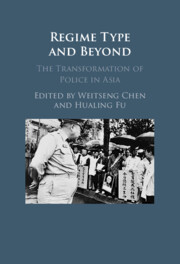Book contents
- Regime Type and Beyond
- Regime Type and Beyond
- Copyright page
- Contents
- Figures
- Tables
- Contributors
- Abbreviations
- Part I Framework
- Part II Authoritarian Policing: Past and Present
- 3 High Policing and Human Rights Lawyering in China
- 4 Transformation in Policing Minor Offending in China
- 5 From Revolutions to COVID-19
- 6 Unrestrained but Limited
- Part III Democratic Transition and Authoritarian Resilience
- Part IV The Singapore and Hong Kong Exceptions
- Part V Conclusions
- Index
3 - High Policing and Human Rights Lawyering in China
from Part II - Authoritarian Policing: Past and Present
Published online by Cambridge University Press: 25 May 2023
- Regime Type and Beyond
- Regime Type and Beyond
- Copyright page
- Contents
- Figures
- Tables
- Contributors
- Abbreviations
- Part I Framework
- Part II Authoritarian Policing: Past and Present
- 3 High Policing and Human Rights Lawyering in China
- 4 Transformation in Policing Minor Offending in China
- 5 From Revolutions to COVID-19
- 6 Unrestrained but Limited
- Part III Democratic Transition and Authoritarian Resilience
- Part IV The Singapore and Hong Kong Exceptions
- Part V Conclusions
- Index
Summary
This chapter studies the interaction between human rights lawyers and activists and political policing in China. While coercion is key to authoritarian governance, coercive and repressive measures in and of themselves do not produce regime resilience and deliver orders, compliance, and effective governance that is commonly observed in China. This chapter examines the systemic use of “soft repression,” which is preventive and preemptive in nature, characterized by surveillance, early intervention, and political persuasion. The process is informal and interactive i nwhich the Chinese political policing systems bring government pressure and other non-state forces to bear on target groups and individuals to achieve compliance. Subtle intimidation, consent under duress, relational repression, and voluntary detention, all hallmarks of China’s political policing, which is referred to as coercive political persuasion, have worked to constrain legitimate advocacy without frequently resorting to direct violence or blatant violation of legal rules.
Keywords
- Type
- Chapter
- Information
- Regime Type and BeyondThe Transformation of Police in Asia, pp. 53 - 86Publisher: Cambridge University PressPrint publication year: 2023

